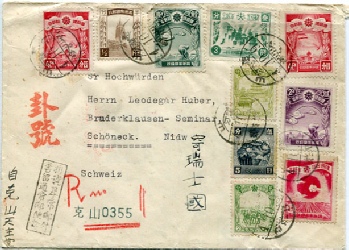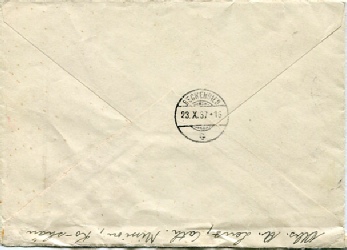
Cliquez sur les images pour agrandir -

LETTRE
9 octobre 1937 -
–
October 9th, 1937 -
|
Dimensions : |
160 x 115 mm |
|
|
Tarif : |
Lettre internationale, pour 20g…. Recommandation………………. Total……………………………… |
20 fens 16 fens 36 fens |
|
Période de valeur : |
01/04/1936 au 28/02/1942 |
|
|
Timbres utilisés : |
YT n°38, 74, 79, 81, 94, 95, 103, 104 (x2) et 105 |
|
|
Oblitération : |
N°41.1 Koshan 9/10/1937 |
|
|
Période d’utilisation : |
24/01/1936 au 22/02/1945 |
|
|
Indications : |
«卦 號 » recommandé en chinois (1ère date répertoriée), « 0355 » N° du recommandé, « R n° » manuscrit, « 掛 號 尋 常 郵 件 - |
|
|
Transit : |
Oblitération Beckenried 23/10/1937 |
|
|
Arrivée : |
NC |
|
|
Size : |
160 x 115 mm |
|
|
Rate : |
Foreign letter, first 20g………… Registration fee………………… Total…………………………….. |
20 fen 16 fen 36 fen |
|
Period of rate : |
04/01/1937 to 02/28/1942 |
|
|
Stamps : |
SG n°40, 67, 82, 84, 101, 102,112, 113 (x2) and 114 |
|
|
Postmark : |
N°41.1 Koshan 10/09/1937 |
|
|
Period of use : |
01/24/1936 to 02/22/1945 |
|
|
Instructions : |
«卦 號 » registered in Chinese (first listed date), « 0355 » registration number, « R n° » handwritten, « 掛 號 尋 常 郵 件 - |
|
|
Transit : |
Postmark Beckenried 10/23/1937 |
|
|
Arrival : |
NC |
|
Cette enveloppe qui -
D’abord l’affranchissement qui est certainement philatélique tout en respectant le tarif en vigueur. Ensuite, le cachet «卦 號 » (guà hào) -
Et enfin cet autre cachet « 掛 號 尋 常 郵 件 » (guà hào xún cháng yoù jiàn) Ce qui littéralement signifie : « Courrier recommandé ordinaire ». Précision due, vraisemblablement, au manque d’étiquette de recommandé. De plus, le fait qu’il soit bilingue, chinois-
(1) Source : Dictionnaire Chinois-


At first glance, this envelope might seem ordinary, but it's not at all.
First of all, the franking is certainly philatelic, while respecting the current rate. Secondly, the mark "卦 號 " (guà hào) -
And finally the other mark "掛 號 尋 常 郵 件 " (guà hào xún cháng yoù jiàn) which literally means: "Ordinary registered mail". This is probably due to the lack of a registered mail label. What's more, the fact that it is bilingual, Chinese-
(1) Source : 1924 Chinese-